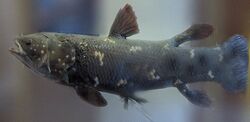Biology:Latimerioidei
| Latimerioidei | |
|---|---|

| |
| Latimeria chalumnae, a latimeriid | |

| |
| Mawsonia gigas, a mawsoniid | |
| Scientific classification | |
| Domain: | Eukaryota |
| Kingdom: | Animalia |
| Phylum: | Chordata |
| Clade: | Sarcopterygii |
| Class: | Actinistia |
| Order: | Coelacanthiformes |
| Suborder: | Latimerioidei Schultze, 1993 |
| Families | |
Latimerioidei is a suborder of coelacanths that contains both extant species of coelacanth in the genus Latimeria. It is defined as "the least inclusive clade containing Latimeria chalumnae and Mawsonia gigas".[1]
It is divided into two families: the extant Latimeriidae, an entirely marine group that survives to the present day with both Latimeria species (with a number of fossil genera also known) and the extinct Mawsoniidae, which inhabited both freshwater and marine habitats and went extinct during the Late Cretaceous (Maastrichtian).[2][3] This suborder contains the largest coelacanths known to have existed, including the latimeriid Megalocoelacanthus and the mawsoniid Mawsonia.[4] The earliest known member of the group is the Permian mawsoniid Changxingia, although divergence estimates instead predict an Early Triassic origin.[5][6]
The Latimerioidei may have evolved from the Whiteiidae, an extinct family of coelacanths known from a few Triassic-aged genera.[2]
References
- ↑ Dutel, Hugo; Maisey, John G.; Schwimmer, David R.; Janvier, Philippe; Herbin, Marc; Clément, Gaël (2012-11-27). "The Giant Cretaceous Coelacanth (Actinistia, Sarcopterygii) Megalocoelacanthus dobiei Schwimmer, Stewart & Williams, 1994, and Its Bearing on Latimerioidei Interrelationships" (in en). PLOS ONE 7 (11): e49911. doi:10.1371/journal.pone.0049911. ISSN 1932-6203. PMID 23209614. PMC 3507921. https://journals.plos.org/plosone/article?id=10.1371/journal.pone.0049911.
- ↑ 2.0 2.1 Uyeno, Teruya; Yabumoto, Yoshitaka (November 2007). "ORIGIN OF EXTANT COELACANTHS". https://www.researchgate.net/profile/Teruya-Uyeno/publication/257922614_Origin_of_extant_coelacanths/links/0deec5261db5d26deb000000/Origin-of-extant-coelacanths.pdf.
- ↑ Cavin, Lionel; Buffetaut, Eric; Dutour, Yves; Garcia, Géraldine; Le Loeuff, Jean; Méchin, Annie; Méchin, Patrick; Tong, Haiyan et al. (2020-06-05). Carnevale, Giorgio. ed. "The last known freshwater coelacanths: New Late Cretaceous mawsoniid remains (Osteichthyes: Actinistia) from Southern France" (in en). PLOS ONE 15 (6): e0234183. doi:10.1371/journal.pone.0234183. ISSN 1932-6203. PMID 32502171.
- ↑ Dutel, Hugo; Maisey, John G.; Schwimmer, David R.; Janvier, Philippe; Herbin, Marc; Clément, Gaël (2012-11-27). Soares, Daphne. ed. "The Giant Cretaceous Coelacanth (Actinistia, Sarcopterygii) Megalocoelacanthus dobiei Schwimmer, Stewart & Williams, 1994, and Its Bearing on Latimerioidei Interrelationships" (in en). PLoS ONE 7 (11): e49911. doi:10.1371/journal.pone.0049911. ISSN 1932-6203. PMID 23209614. PMC 3507921. https://dx.plos.org/10.1371/journal.pone.0049911.
- ↑ "Fossilworks: Latimeroidei". http://www.fossilworks.org/cgi-bin/bridge.pl?a=taxonInfo&taxon_no=202305.
- ↑ Toriño, Pablo; Soto, Matías; Perea, Daniel (2021-12-02). "A comprehensive phylogenetic analysis of coelacanth fishes (Sarcopterygii, Actinistia) with comments on the composition of the Mawsoniidae and Latimeriidae: evaluating old and new methodological challenges and constraints". Historical Biology 33 (12): 3423–3443. doi:10.1080/08912963.2020.1867982. ISSN 0891-2963. https://doi.org/10.1080/08912963.2020.1867982.
Wikidata ☰ Q21220246 entry

